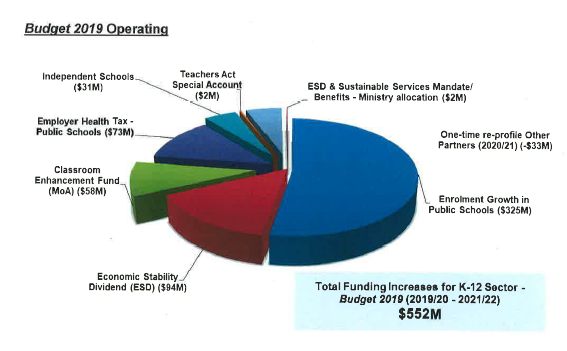BCTF Research Note, April 2019
You may have heard the Minister of Education recently say that there is more money than ever in British Columbia’s public education system. In a Vancouver Sun op-ed published on April 24, he wrote that the past years have seen “the largest funding increases in B.C.’s public education system ever, with nearly $1 billion in new money to give students more support in the classroom.”
This is not wrong, technically. The good news is that there is new funding; the bad news for the Ministry of Education is that other stakeholders are largely responsible for it. Nearly all new money in the K-12 system is due to the enrolment growth, restored teacher collective agreement language on class size and class composition or previously-agreed-to salary increases. These are all non-discretionary factors over which the Ministry has no control.
When the Ministry has had the opportunity to put real new resources into classrooms—for example to fully support the implementation of a new curriculum—it has come up short. Despite including some necessary increases for students with special needs, the recently-announced funding changes for the 2019/20 school year amount to just 1.3% per student. That is far below the rate of inflation and will force districts to make tough choices about where to impose service cuts.
Thank teachers and students for “largest increases”
First, to see who or what is responsible for new money in the loudly-trumpeted “largest funding increases,” examine the following chart put out by the Ministry of Education to accompany the 2019 provincial budget:

Incremental funding increases between 2019/20 and 2021/22 are being driven by (1) rising enrolment, (2) the Classroom Enhancement Fund (CEF) and (3) salary increases from agreements already in force (the Economic Stability Dividend). Over half of every “new” dollar is flowing to schools simply because there are more students to teach, and together these three things comprise 87% of all additional money slated for public schools in this year’s budget. The remainder is money to enable school boards to pay the new Employer Health Tax in full.
Enrolment, CEF increases and negotiated salary increases were also 98% of new money for public schools in the 2018 budget. The CEF itself, in place since 2017 and required by the Supreme Court decision restoring the teachers’ collective agreement, has generated $432 million more for public schools just in the current school year!
Other than more students in our schools, it is clear that teacher collective agreements, in particular provisions to limit class sizes and generate supports for students with special needs, are the only tool actually driving truly new resources into BC’s public K-12 classrooms.
Funding formula amounts still not keeping up with inflation
What does this new money mean on a year-to-year basis? The Ministry of Education has also been advertising changes to the funding formula amounts for the coming school year. There is much-delayed good news for some students, but the overall sum of resources going into classrooms is growing by less than inflation.
The good news is that the three funding allocations for students with special needs, the ELL allocation as well as the allocation for Indigenous students are all getting a badly-needed boost. However, adjusted for inflation, each of these funding amounts is 5% lower today than it was in 2010. In a way, these changes are largely playing catch-up. In 2019, school districts will receive 9% more money per student with Level 1 special needs (now $42,400), 4% more per student with Level 2 special needs (now $20,200), 5% more per student with Level 3 special needs (now $10,250), 5% more per ELL student (now $1495) and 17% more per Indigenous student (now $1450).
Unfortunately, the base per-student allocation that districts receive for each and every student is growing by a mere 0.6% or $45. As this allocation comprises 79% of total formula-generated funds, its very limited increase overshadows the larger increases above.
Putting it all together, formula-driven operating funding per student is only growing by 1.3%.
Remember that inflation in BC was 2.7% in 2018 and is projected to be 2.2% in 2019. This means that operating increases are running at roughly half of inflation. In past years, below-inflation funding increases have meant that many school districts had to make cuts to services as their costs outpaced the resources flowing from the province.
Despite the rhetoric about historic funding increases, next year may yet turn out to be no different. After so many years of cuts to classrooms, British Columbia students deserve better.